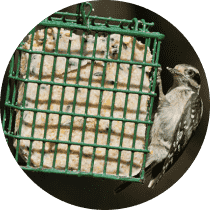Brown Creeper
A species of Typical Treecreepers, Also known as American Treecreeper Scientific name : Certhia americana Genus : Typical Treecreepers
Brown Creeper, A species of Typical Treecreepers
Also known as:
American Treecreeper
Botanical name: Certhia americana
Genus: Typical Treecreepers
Content
Description People often ask General Info
 Photo By Andy Reago & Chrissy McClarren , used under CC-BY-2.0 /Cropped and compressed from original
Photo By Andy Reago & Chrissy McClarren , used under CC-BY-2.0 /Cropped and compressed from original Description
Adults are brown on the upper parts with light spotting, resembling a piece of tree bark, with white underparts. They have a long thin bill with a slight downward curve and a long stiff tail used for support as the bird creeps upwards. The male creeper has a slightly larger bill than the female. Relatively, brown creepers are smaller than white-breasted nuthatches but larger than golden-crowned kinglets. Measurements: Length: 4.7-5.5 in (12-14 cm) Weight: 0.2-0.3 oz (5-10 g) Wingspan: 6.7-7.9 in (17-20 cm) Its voice includes single very high pitched, short, often insistent, piercing calls; see, or swee. The song often has a cadence like; pee pee willow wee or see tidle swee, with notes similar to the calls. 
Size
13 cm
Colors
Brown
Bronze
White
Life Expectancy
4 years
Nest Placement
Tree
Clutch Size
5 - 6 eggs
Incubation Period
1 brood
Number of Broods
13 - 17 days
Nestling Period
14 - 20 days
Feeding Habits
In breeding, brown Creeper consume varied insects and arthropods, meticulously searching furrowed bark of large trees. Non-breeding season diversifies their diet with some seeds and plant materials. At feeders, they may partake in suet and seed offerings. Their long bills are adapted for probing, gleaning, pecking during tree ascent.
Habitat
Brown Creeper is commonly found in mature, moist forests, primarily coniferous or mixed coniferous/deciduous. This bird favors environments with large trees for foraging and loose-barked trees for nesting. Although preferring habitats up to 4,500 feet in elevation in eastern North America, brown Creeper can be found as high as 11,000 feet near treelines in the western regions. In winter, brown Creeper inhabits a broader range of wooded areas, from deciduous forests to urban parks and orchards. They are often associated with oak-hickory forests and tree savannas in some areas.
Nest Behavior
Both adults select the site, but only the female constructs the nest over one to two weeks, assisted by the male who gathers materials. Egg-laying follows nest construction, and both parents engage in the care of the eggs and hatchlings.
Nest Characteristics
Brown Creeper's nest is usually situated between a tree trunk and loose bark, often on a dead or dying tree within dense stands. The nest is built up to 40 feet high using twigs, bark strips, insect cocoons, spider egg cases, wood fibers, hair, feathers, grass, leaves, lichens, and mosses, forming a cup about 2.5 inches deep and 6 inches across.
Dite type
Insectivorous
General Info
Feeding Habits
Bird food type

Hulled Sunflower Seeds

Suet

Peanut Hearts
Bird Feeder Type

Suet Cage
Sounds
Call
Recording location: Mexico
Song
Recording location: Mexico
Behavior
Brown Creeper typically display a unique method of foraging by spiraling upward along tree trunks, utilizing their curved claws and stiff tails for support. This vertical hopping technique is conducive to their insectivorous diet. Their downward movement, however, is less efficient, leading them to glide to the base of neighboring trees to resume foraging. During breeding, brown Creeper exhibit territorial singing and perform dynamic aerial spirals to attract mates, likely maintaining monogamous relationships. Post-fledging, both parents contribute to offspring care. Seasonal changes bring shifts in behavior; winter sees brown Creeper joining mixed-species foraging groups and engaging in communal roosting. They present a freeze response to predation threats and are known to actively join in mobbing predators.
Distribution Area
Their breeding habitat is mature forests, especially conifers, in Canada, Alaska and the northeastern and western United States. They are permanent residents through much of their range; many northern birds migrate farther south to the United States. Brown creeper has occurred as a vagrant to Bermuda and Central America's mountains in Guatemala, Honduras and the northern cordillera of El Salvador. As a migratory species with a northern range, this species is a conceivable vagrant to western Europe. However, it is intermediate in its characteristics between common treecreeper and short-toed treecreeper, and has sometimes in the past been considered a subspecies of the former, although its closest relative seems to be the latter (Tietze et al., 2006). Since the two European treecreepers are themselves among the most difficult species on that continent to distinguish from each other, a brown creeper would probably not even be suspected, other than on a treeless western island, and would be difficult to verify even then. Brown Creepers prefer mature, moist, coniferous forests or mixed coniferous/deciduous forests. They are found in drier forests as well, including Engelman Spruce and larch forest in eastern Washington. They generally avoid the rainforest of the outer coast. While they generally nest in hardwoods, conifers are preferred for foraging. 
Species Status
As with many of Washington's birds, the Cascades divide this species into two subspecies. The species has declined in much of North America but appears to be doing well in Washington, with a small (not significant) increase on the state's breeding bird survey since 1966. 

 Photo By Andy Reago & Chrissy McClarren , used under CC-BY-2.0 /Cropped and compressed from original
Photo By Andy Reago & Chrissy McClarren , used under CC-BY-2.0 /Cropped and compressed from original Scientific Classification
Phylum
Chordates Class
Birds Order
Perching birds Family
Treecreepers Genus
Typical Treecreepers Species
Brown Creeper